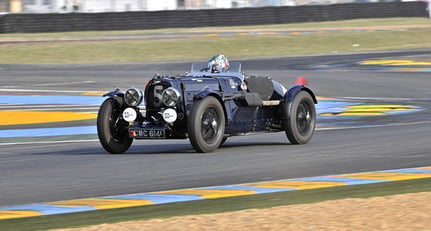1935
-
Baujahr1935
-
ChassisnummerB5/549/U
-
MotornummerB5/549/U (see text)
-
Losnummer351
-
LenkungLenkung links
-
ZustandGebraucht
-
Zahl der Sitze2
-
Standort

-
AußenfarbeSonstige
-
Antrieb2wd
-
KraftstoffPetrol
Beschreibung
The ex Le Mans and RAC Tourist Trophy, M.F.L. Falkner/TommyClarke ex Mille Miglia, E.R. Hall/Marsden ex Targa Abruzzo, Count 'Johnny' Lurani/GildoStrazza ex Derrick Edwards Morntane Engineering
1935 Aston Martin Ulster Competition Sports
Registration no. CMC 614
Chassis no. B5/549/U
Engine no. B5/549/U (see text)
To anyone within the Aston Martin world, Derrick Edwards was a legendary figure. He was a marque specialist restorer, preparer, tuner and racer whose name and reputation became absolutely synonymous with Aston Martin's 1930s finest. He was the man who founded Aston Martin specialist Morntane Engineering, from which grew Ecurie Bertelli, taking the family name of Augusto Cesare 'Bert' Bertelli, whose family directed the Aston Martin company's progress and fortunes from 1926 to 1937.
Bonhams is privileged to offer the car which was Derrick Edwards' personal Aston Martin Ulster, the machine he raced, tuned, raced, lightened and raced again, and again, for more than 30 years...
Whenever he made a far-reaching modification to the car in search of saving another elusive half-second around the classic and historic racing circuits of the world, Derrick Edwards carefully preserved any original components removed. Today these have been returned to the car, which is now presented here in virtually the same configuration as presented during its International heyday of frontline competition, when it represented the honour of the British motor industry in such prestigious events as the 1935 Le Mans 24-Hour Grand Prix d'Endurance, the Mille Miglia, and the grueling Targa Abruzzo at Pescara on Italy's Adriatic coast.
In the Aston Martin Owners' Club Register of Members' Cars the exhaustive listing of individual histories is headed in extent by that for Derrick Edwards' 'CMC 614' as offered here. In 2002, a 'Motor Sport' magazine feature upon the car described how "It's one of those cars which needs the right owner, so when the time came to sell six years ago it wasn't advertised; instead Andy Bell, the guru of Ecurie Bertelli, quietly rang up (fellow marque aficionado) Fred Blakemore and suggested it was his turn to become guardian". He in turn recalled how Mr Edwards had long before "...let me drive CMC, and even then I thought it was a superb car to drive".
The car is one of the rarefied and intensely desirable group of only 21 Aston Martin Ulster sports cars which were manufactured by the Bertelli-directed company in its Feltham workshops, built closely to the same specification as the illustrious LM-prefixed factory team cars which had previously garnered the Team Prize in the 1934 RAC Tourist Trophy race around the Ards circuit in Ulster, hence the model name. They were lightweight versions of the Aston Martin Mark II, featuring 1496cc dry-sump 4-cylinder engines and handsome, elegantly-proportioned bodies, and were guaranteed to provide the proud new owner with genuine 100mph motoring.
Aston Martin Ulster 'CMC 614' made its competition debut in nothing less than the most grueling endurance race of the 'tween-war years, the Italian Mille Miglia. First to compete in 'CMC 614' was that great British motor sportsman, Edward Ramsden 'Eddie' Hall, of Kirkburton near Huddersfield. He was heir to a successful Yorkshire textiles business which funded his motor racing and other sporting exploits. He lived at Kirkburton near Huddersfield, was burly, powerfully built and outgoing. He favoured races that demanded personal stamina, and is best remembered today for his multiple drives in the Tourist Trophy race at Ards in Ulster, in which he appeared every year it was run, from 1928-1936.
Partnered by friend and mechanic Marsden in the 1935 Mille Miglia, he fought for the class lead with 'CMC' now offered here before having to retire at Siena with the Aston Martin leaking oil. The problem was quickly corrected back at Feltham and the car prepared for the Le Mans 24-Hours, in which two other prominent British amateur drivers of the period, Maurice Falkner and Tommy Clarke, survived the full duration to finish eighth overall, second of the Aston Martin entries and part of the winning team of the Rudge Whitworth Cup.
Eddie Hall then entered the car for the Targa Abruzzo 24-Hour race on the long Pescara road circuit in Italy. His co-driver was to be Count Giovanni 'Johnny' Lurani but when they met on the road outside Pescara, the outgoing, urbane Italian aristocrat was startled to find Eddie Hall most unhappy. His hotel had proved abysmal, he had not in any way received the welcome he had been expecting and without further ado he left for home, leaving the car and a team of Aston Martin works mechanics there to support them kicking their heels.
Lurani evidently then spent a fraught three days trying to contact 'Bert' Bertelli who was somewhere on an Italian holiday. Once contact had been made, Lurani sought permission to run 'CMC' in the Pescara race. Bertelli happily agreed terms, and Lurani shared its driving with ErmenegildoStrazza to finish quite handsomely, first in the 1.5 litre class, third on handicap and fifth on the road.
Eddie Hall never did step up to the plate and buy the car from the Aston Martin factory. He concentrated instead upon his Derby Bentley 'TT special', and in 1936 this Aston Martin went instead to its alternative first owner ex-works, one Ian Porter-Hargreaves.
He tried to enhance its 1½-litre engine's performance by fitting a Centric supercharger, but over the following three years the car in his hands did not achieve startling success. Although the Centric supercharger was removed from 'CMC' many years ago, the bonnet bulge to accommodate it remains in place.
Porter-Hargreaves retained the Aston Martin during the war years 1939-45, eventually selling it to a fellow enthusiast named McNab-Meredith. The supercharger was removed at some point during his tenure, and it was from him that Derrick Edwards bought the car in 1963.
He began a hectic competition career in the car which saw him racing, sprinting or hill-climbing almost every weekend, not only in the British Isles but also on Continental tours in Europe. In a 'Motor Sport' magazine feature on the car in the June 2002 issue, Fred Blakelock is quoted: "He went out almost every weekend. At first he would drive to the events, but as the car became more highly modified he began to trailer it. The car even went round the world in a container. He sent it to Laguna Seca, got there with minutes to spare before qualifying, then couldn't get it to start. He repacked it in its container and it went on to complete the journey. His comment was 'I hope it enjoyed its trip...". Indeed the cars fame became such that during Edwards ownership it was 'CMC' that was chosen by Matchbox to be the example of this famous model which they modeled for their Airfix 1/32 kit.
Over the many years through which he campaigned 'CMC', Derrick Edwards constantly modified it to save split seconds in competition. Like all his rivals he adopted small-diameter, wider-rim wheels, replaced its 25-gallon fuel tank with a sprint replacement good for ten laps round Silverstone. The engine painstakingly rebuilt for Mr Edwards by Eckhart Berg - received a bunch-of-bananas exhaust system, the suspension was stiffened and dampers uprated, every surplus ounce of weight was saved. The Derrick Edwards Aston Martin Ulster became a familiar and famous Alfa and Invicta eater. Most importantly, Derrick Edwards carefully stored everything he had removed from the car during this development programme, and in Fred Blakemore's later stewardship they were all conscientiously refitted returning 'CMC' (liveried in his favourite and familiar dark blue) closely to its original 1930s specification.
Despite its hectic competition programme 'CMC' proved incredibly reliable. Part of this longevity has been due to the engine being assembled with shell bearings instead of white metal and steel connecting rods instead of duralumin. The unit ran safely to 5,500rpm, and Derrick Edwards quoted its power output as being nearer to 120bhp than to Feltham's original 85. This would have been reduced to around a current 105bhp when the original cast exhaust manifold was refitted, but with benefit of constant improvement in cam design, valve-gear, valve springs and breathing. At some point, the original cylinder block and head have been replaced, this representing the only significant disruption to the fabric of this remarkable car during its long life.
The Ulster model is widely considered to have been the best handling of pre-war Aston Martins and many who have driven 'CMC' in recent years rate it amongst the best, of the best. In the middle of Derrick Edwards' ownership of this most respected pre-war Aston Martin, he founded his marque specialist business Morntane Engineering together with his partner Judy Hogg and Pink Floyd musician and competition car enthusiast Nick Mason (who briefly owned 'CMC'). Andy Bell, in whose specialist and painstaking hands 'CMC' has been prepared in recent years, worked at Morntane and took over the business in 1992.
More recently during the current ownership 'CMC' has been fastidiously prepared and maintained by leading pre War Aston Martin race preparer Alan Brooke (formerly of Ecurie Bertelli) and under the current ownership has wanted for nothing. Completing two Mille Miglia retrospectives and two Le Mans Classics entirely without problem, along with scores of club races, nobly upholding this car's matchless competition pedigree.
Professional writer-cum-racing driver Mark Hales drove the car at Aston Clinton hill-climb for a commemorative article in 2013 and described how, upon first acquaintance, Andy Bell had walked "...me round, pointing out the original body panels, a detail that seems extraordinary given the amount of racing the car has done, and the original piping round the cockpit edges that looks like a piece of garden hose but reveals a hint of the car's 1930s emerald green livery. The seats are original too and a huge improvement over many. A deep wrap-around bucket but, most important, whose sides extend upwards to support the torso. There aren't any belts, but you still feel located".
On the road, Mark Hales found the car "Simple, strong, reliable, low centre of gravity and benign handling all the characteristics that made it successful in the 1930s have held good for the many years in between, and are still true today. That's why it gets raced as much as it does, and probably always will...".
There writes a dyed-in-the-wool racer, but 'CMC 614' as offered here is not only perhaps the best-known and most revered Aston Martin Ulster of them all, but it is offered here as a tremendously versatile all-rounder, a post-Vintage thoroughbred sports car which is at much at home on the race circuits of the world such as Le Mans Classic or on the public road, which would be ideal for long-distance touring or for any of the current Historic motoring world's greatest sprint, hill-climb, and rally-style events. As a genuine Works run 1935 Aston Martin Ulster, ex-Le Mans, ex-Mille Miglia and ex-Targa Abruzzo plus its incredible, absolutely jam-packed history of postwar competition this chance to acquire 'CMC 614' "...on the button and ready to go" is a very significant opportunity indeed. We recommend the closest consideration.

























